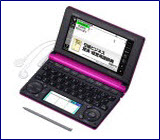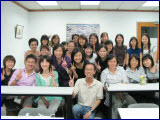- Home
- Learn Japanese Language FAQ
- How to determine onyomi and kunyomi of each kanji character?
How to determine onyomi and kunyomi of each kanji character?
by S. Soundararajan
(Karur, Tamilnadu, India)

音読み vs 訓読み Onyomi vs Kunyomi
Dear sir, I have great difficulty in determining onyomi and kunyomi of each and every kanji. The only thing was to memorize them but it takes too long period. Is there is any useful and simple method to determine onyomi and kunyomi of each kanji?
Please help in this matter. For ex: san - onyomi, yami - kunyomi. We use "san" while in the combination with another kanji (fuji san), while "yama" in separate used words. But how the onyomi-san, kun yomi-yama, each kanji's onyomi and kunyomi was determined. Please give answer. Thank You.
Reply:
Hi S. Soundararajan,
Frankly speaking, I do not think there is any simple way to determine onyomi and kunyomi of each kanji.
As you know, 音読み (onyomi), which literally means "sound reading", is the Chinese reading of kanji. 訓読み (kunyomi), on the other hand, is the Japanese reading of kanji.
It is a reading based on the pronunciation of a native Japanese word. Most kanji have both readings, just like 山 (san for onyomi, yama for kunyomi) you mentioned in your question.
Some of them have only one type of reading. For example, this kanji 秒, which means second (as in hour, minute and second), has only onyomi byou.
Whereas most kanji created by Japanese have only kunyomi. For example, this kanji 畑 which means field (field of crops) has only kunyomi hatake.
However, even in onyomi and kunyomi, there are multiple on and kun readings for the same kanji. For example, this kanji 日, the onyomi can be にち (nichi) or じつ (jitsu), the kunyomi can be ひ (hi), び (bi) or か (ka).
With so many different readings, there are really no specific hard rules that you can use to find out which reading to use in different situations.
All I can say is that you have to keep on practising and get familiarized with the Japanese kanji vocabulary. You will then know which to use in different situations.
I have consulted my native Japanese teachers on this issue when I was studying my Japanese. Even as native speakers, they sometimes also have problems determining which one to use for certain kanji.
They did show me some general guidelines in determining when to use onyomi or kunyomi. Unfortunately, these guidelines are only true to certain extent because there are just too many exceptions where these guidelines cannot be applied.
Just like you, I also do not like to memorize kanji by hard. But as you know, language is not like mathematics where you can apply one rule and get the answer straightaway.
There are many things like culture, history, etc, that influenced how the language of a country developed in such a way.
I hope I have not scared you in learning the different readings of kanji with the above reasons. Below are some general guidelines to determine when to use onyomi or kunyomi.
These guidelines are some helpful aids that may speed up your learning on different readings
1. 送り仮名 Okurigana
Kunyomi is always used in a single kanji followed by okurigana, which are hiragana characters forming part of the word. These are commonly seen in verbs and adjectives.
For example, in this verb 食べる (taberu), the kanji 食 (shoku - onyomi) is pronounced as "ta" in kunyomi (べる is the okurigana). In this adjective 白い (shiroi), the kanji 白 (haku - onyomi) is read as "shiro" in kunyomi.
2. Single Kanji
Kunyomi is normally used for a standalone kanji without hiragana attached to it. For example, the words for the 4 directions - north, south, east and west, are pronounced as 北 (kita), 南 (minami), 東 (higashi), 西 (nishi) respectively, all in kunyomi.
3 Multi-kanji Compound Words
Onyomi is mostly used with 2 or more kanji in a Japanese word. For example, 2-kanji compound words like 法律 (houritsu), 家族 (kazoku), 衣服 (ifuku). 3-kanji compound words like 警察官 (keisatsukan), 銀行員 (ginkouin), 低気圧 (teikiatsu).
4-kanji compound words like 四字熟語 (yojijukugo) are also usually read using onyomi. For example, 一石二鳥 (issekinichou), 前代未聞 (zendaimimon) and 危機一髪 (kikiippatsu).
But there are many exceptions where kunyomi is being used for multi-kanji compound words. For example, this 2-kanji compound words 手紙 (tegami) is read using kunyomi.
4. Names of Native Japanese
Although names of native Japanese are written in multiple kanji, they are pronounced in kunyomi most of the time (though there are still exceptions).
Some examples are family names like 水野 (mizuno), 高松 (takamatsu), 木村 (kimura) and 藤井 (fujii) which are read using kunyomi. But exceptions like 伊藤 (itou), 佐藤 (satou) and 陣内 (jinnai) are read using onyomi.
5. Name of Places
Name of Places in Japan are mostly read with kunyomi. For example, 長野 (nagano), 青森 (aomori), 熊本 (kumamoto), 旭川 (asahikawa) and 箱根 (hakone). However, there are still some exceptions like 東京 (toukyou) and 北海道 (hokkaidou) which are read using onyomi.
Even with the above guidelines, I think you may still be confused with how to determine which reading to use.
Due to the multiple readings in both onyomi and kunyomi, even a native speaker may not always know how to read a kanji without prior knowledge, especially the names of people and places.
Summary
In summary, the only way (you may disagree) that I find most useful in determining onyomi and kunyomi of kanji is to keep on reading and studying more kanji.
The more you read and study, the more kanji you will know and how they are being read and used. I know this method will take a long time before you actually see some results.
But why not think in a different perspective. Learning a new language usually takes us years to really master it. Think about how you studied your own native language. How long did you take to fully master it?
You might want to refer to the section on "When to use which reading" in this wikipedia page for reference.
Related Pages
Japanese Hiragana.
Japanese Katakana.
Japanese Kanji.
Hope this helps,
Kia Leng
Comments for How to determine onyomi and kunyomi of each kanji character?
|
||
|
||
|
||
|
||
|
||
|
||
|
||
|
||
|
||
|
||
|
||
|
||
|
||
|
||
|
||
|
||
|
||
|
||
|
||
|
||
|
||








